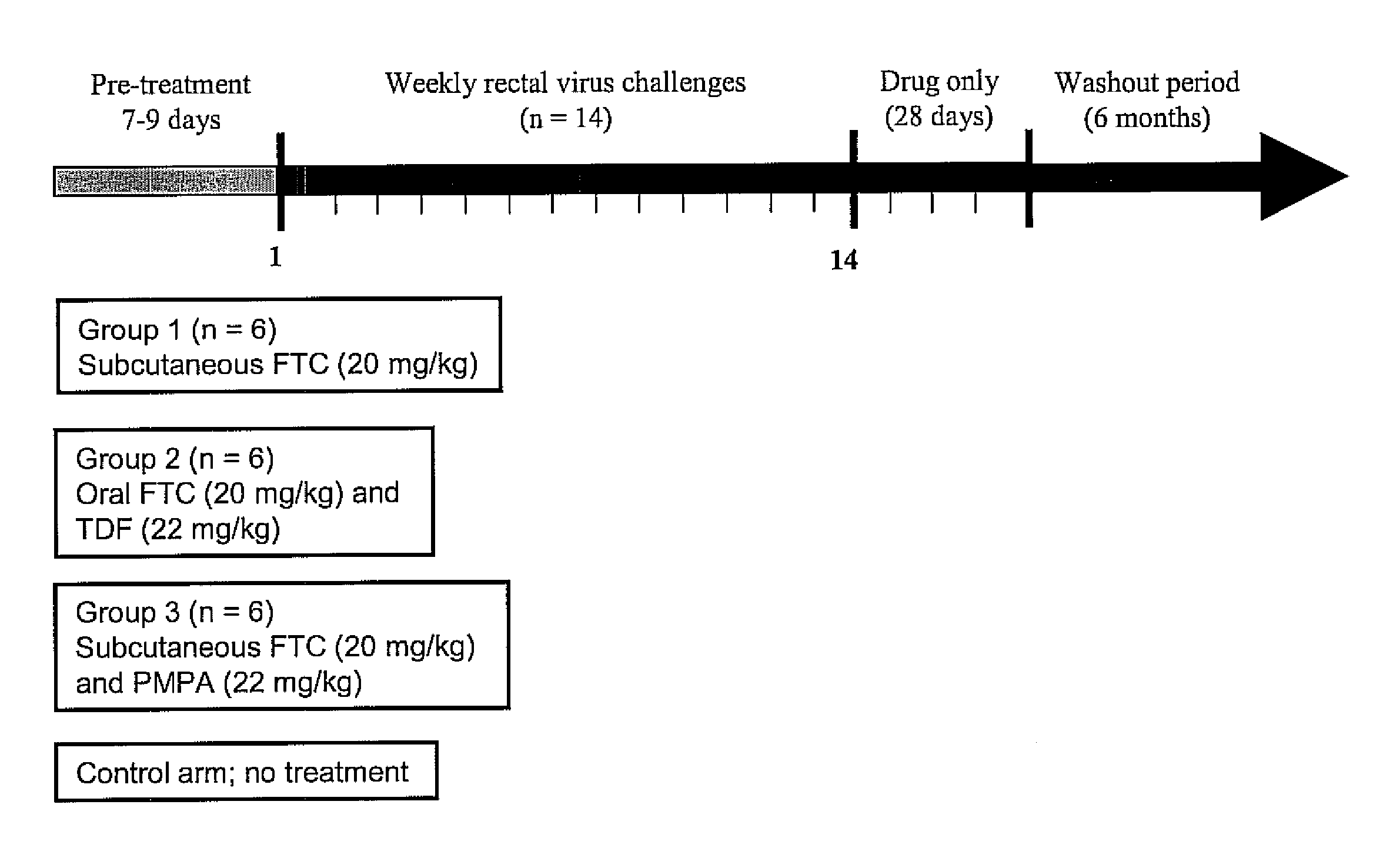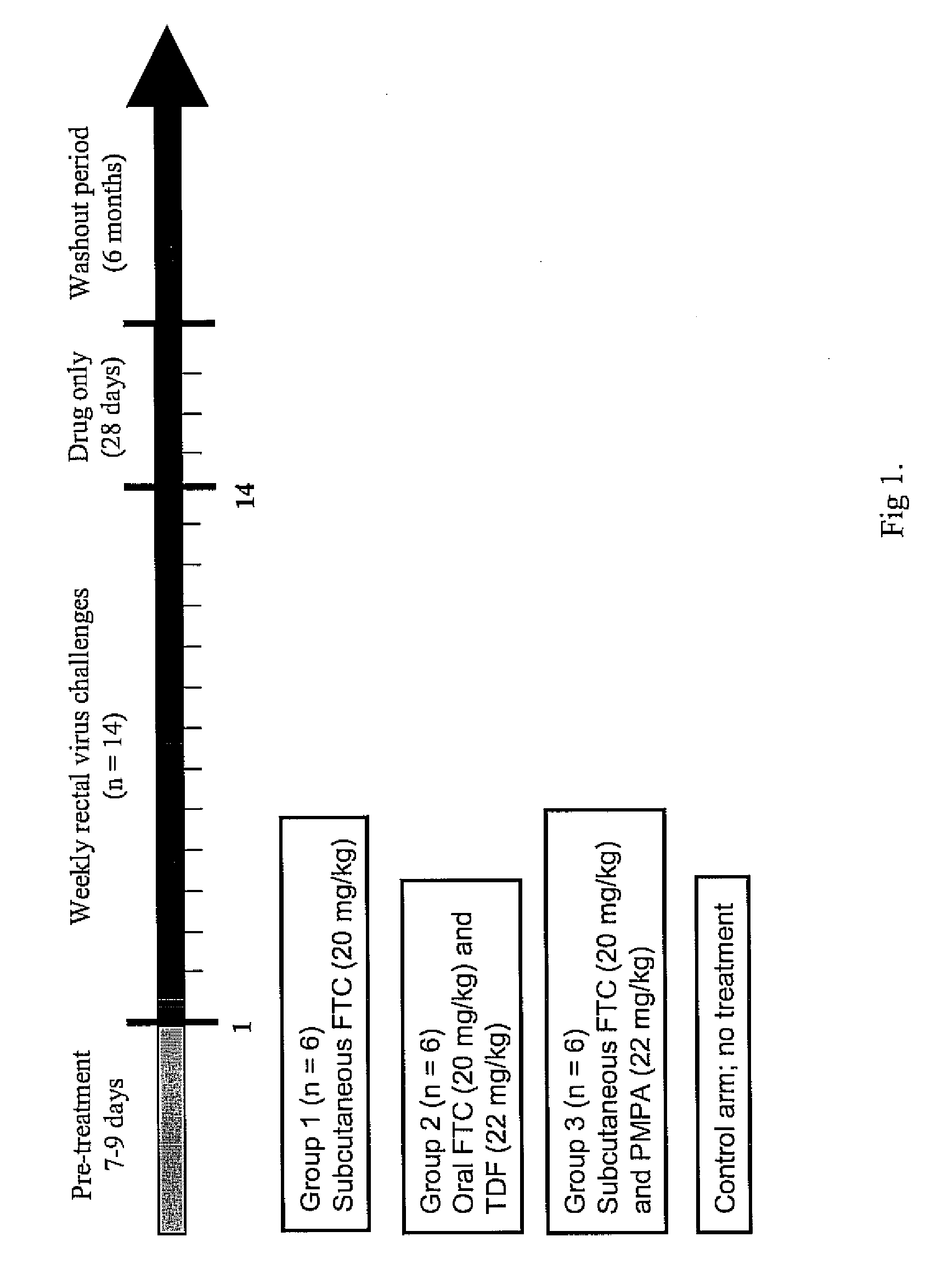Inhibition of HIV infection fhrough chemoprophyalxis
a technology of chemoprophylaxis and hiv infection, which is applied in the field of inhibition of hiv infection fhrough chemoprophylaxis, can solve the problems of retaining the potential to infect others, unable to prevent new infections, and previous attempts at pre-exposure prophylaxis have met with limited success, so as to reduce the risk of contracting self-replicating immunodeficiency
- Summary
- Abstract
- Description
- Claims
- Application Information
AI Technical Summary
Benefits of technology
Problems solved by technology
Method used
Image
Examples
example 1
- Antiretroviral Drugs and Doses
[0034] A dose of 22 mg / kg of tenofovir disoproxil fumarate (TDF) is given orally and 20 mg / kg of emtricitabine (FTC) given orally or subcutaneously to one group of adult male rhesus macaques. The 22 mg / kg TDF dose resulted in an area-under the plasma concentration-time curve over a 24 h interval (AUC) of 4,49 μg×hr / ml which was similar to the value of 5.02 μg×hr / ml observed in human receiving 300 mg of TDF. The dose of 20 mg / kg of FTC resulted in an AUC value (11 μg×hr / ml), also similar to that observed in humans receiving 200 mg of FTC orally (10.0±3.12 μg×hr / ml)6. Subcutaneous administration of FTC results in plasma FTC levels comparable to those achieved during oral administration, indicating a high FTC absorption in rhesus macaques.
[0035] Oral administration of FTC and TDF to macaques is by mixing the drug powders with peanut butter or fruit. Macaques are observed to ensure ingestion.
example 2
Virus Inoculations
[0036] A chimeric envelope SHIVSF162P3 isolate is used to inoculate the macaques. SHIVSF162P3 is a construct that contains the tat, rev, and env coding regions of HIV-1SF162 in a background of SIVmac239. This isolate was obtained from the National Institutes of Health (NIH) AIDS Research and Reference Reagent Program.7,8 Virus exposures are performed 2 hours after drug treatment, and involved non-traumatic inoculation of 1 mL of SHIVSF162P3 (10 TCID50 or 7.5×106 viral RNA copies) into the rectal vault via a sterile gastric feeding tube.9 Anesthetized macaques remained recumbent for at least 15 min after each intra-rectal inoculation.
example 3
SHIV Viral Load Assay
[0037] Plasma RNA is quantified using a real-time PCR assay as previously described.5 This assay has a sensitivity of detection of 50 RNA copies / ml or 10 copies of a pVp1 plasmid carrying the SIVmac239 RT gene. HIV-RNA is extracted from 1 mL of plasma using the NucliSens extraction method (bioMérieux). A known amount of virus particles (3×105) from an HIV-1 CM240 virus stock is added to each sample prior to extraction to control for the efficiency of extraction. Reverse transcription is performed using 10 microliters (μl) of extracted RNA and the 2-step TaqMan Gold reverse-transcriptase (RT)-PCR kit (Applied Biosystems) according to the manufacturer's instructions, PCR reactions are performed as described using an ABI 7000 Gene Detection System (Applied Biosystems). Virus loads are calculated from a standard curve generated with known amount of virus particles. All primers and probes used for SIVmac239 and HIV-1 CM240 have been reported elsewhere.5 HIV-1 CM240 ...
PUM
| Property | Measurement | Unit |
|---|---|---|
| time | aaaaa | aaaaa |
| body weight | aaaaa | aaaaa |
| body weight | aaaaa | aaaaa |
Abstract
Description
Claims
Application Information
 Login to View More
Login to View More - R&D
- Intellectual Property
- Life Sciences
- Materials
- Tech Scout
- Unparalleled Data Quality
- Higher Quality Content
- 60% Fewer Hallucinations
Browse by: Latest US Patents, China's latest patents, Technical Efficacy Thesaurus, Application Domain, Technology Topic, Popular Technical Reports.
© 2025 PatSnap. All rights reserved.Legal|Privacy policy|Modern Slavery Act Transparency Statement|Sitemap|About US| Contact US: help@patsnap.com



